 Last additions Last additions |
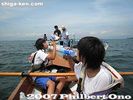
Yes, replenishing your fluids is important...Aug 14, 2007
|
|

"This journey fills my heart with intense happiness..."「さすらいの 旅にしあれば しみじみと」Aug 14, 2007
|
|

And girls on the other fixed-seat boat. These boats have fixed seats which do not slide as in modern rowing boats. This boat is a replica of the fixed-seat boat used 90 years ago by Oguchi Taro and crew when he wrote the song, Biwako Shuko no Uta.Aug 14, 2007
|
|

"We're children of the lake, off to wander 'round..." (Mt. Ibuki in the distance)「われは湖の子...」Aug 14, 2007
|
|

I wanted to experience rowing this fixed-seat boat on Lake Biwa, and rowed with these jr. high girls from Nagahama Port. 千秋・太郎号のフィックス艇Aug 14, 2007
|
|
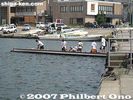
Off we go, boys on one fixed-seat boat.Aug 14, 2007
|
|
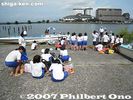
In the morning, two fishing boats pulled the rowing boats from Imazu to Nagahama Port where we met them here. 今津中学校ボート部の琵琶湖周航Aug 14, 2007
|
|

Two fixed-seat boats were also used.Aug 14, 2007
|
|
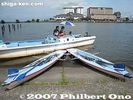
They used five boats to row, including these two ocean scull boats.Aug 14, 2007
|
|
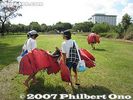
Almost 50 members in the club, and almost all of them participated in this rowing trip. Some of them did this for the third time. Photo: Carrying life vests. All rowers are required to wear life vests.Aug 14, 2007
|
|

On Aug. 8, 2007, I was allowed to join the Imazu Jr. High School Rowing Club as they rowed from Nagahama to Imazu. Photo: A briefing by the club's coach before departure in front of a minshuku lodge near Nagahama Castle.Aug 14, 2007
|
|
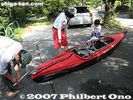
This "Biwako shuko" (Rowing around Lake Biwa) between Imazu and Nagahama was the club's annual summer tradition since 1995. Photo: Assembling a two-man kayak.Aug 14, 2007
|
|

On the day before, they were supposed to row from Imazu to Nagahama, but high waves forced cancellation. So they were bused to Nagahama where they stayed overnight. Photo: Carrying the kayak to the lake, passing by Nagahama Castle.Aug 14, 2007
|
|

"Biwako Shuko no Uta in English, Beloved Song Translated" at Yokaichi Public Library, May 15, 2007, Shiga Hochi Shimbun 滋賀報知新聞Aug 05, 2007
|
|

Group photo. Quite a few people worked during this 3-hour afternoon session.Aug 02, 2007
|
|

Still more tying to do.Aug 02, 2007
|
|

Besides the diagonal grid of bamboo rods, a bamboo rod is also fastened along the edges of the design where the paper will be cut out (or carved out). These bamboo rods keep the edges of the cut-out paper taut. Otherwise it would flap around in the wind.Aug 02, 2007
|
|

Tying the bamboo frame is considered to be one of the more tedious tasks, so we were rewarded with a pair of gloves with the kite design. These gloves will also give us higher priority to pull the kite during the kite festival.Aug 02, 2007
|
|

Aug 02, 2007
|
|

WingAug 02, 2007
|
|

Hawk eye painted.Aug 02, 2007
|
|

Aug 02, 2007
|
|

Bamboo rods and sticks.Aug 02, 2007
|
|

The bamboo frame work is done after the kite design is painted.Aug 02, 2007
|
|

This intricate bamboo frame supports the kite paper so it does not flap around like normal paper.Aug 02, 2007
|
|

Aug 02, 2007
|
|

Kite edges are lined with a thicker bamboo to which the rod-like bamboo are tied.Aug 02, 2007
|
|

July 31, 2007: Bamboo frame work and picture-edge frame work. 骨組(絵骨)Hone-gumi (Ebone)Aug 02, 2007
|
|

Tied bamboo intersections. The rod-like bamboo are supported by larger pieces of bamboo.Aug 02, 2007
|
|

A diagonal grid of thin, rod-like bamboo criss-crossed the entire kite. They are now using string to tie the bamboo intersections.Aug 02, 2007
|
|

Aug 02, 2007
|
|

Aug 02, 2007
|
|

Vermilion painting of "sei" is complete.Aug 02, 2007
|
|

Group photo of those who worked on the kite this time. This session was 9:30 am to noon.Aug 02, 2007
|
|

A brush stroke effectAug 02, 2007
|
|

Aug 02, 2007
|
|

Aug 02, 2007
|
|

Hawk eyeAug 02, 2007
|
|

The sketch of the hawk is completed.Aug 02, 2007
|
|

"Yorokobu" or "ki"Aug 02, 2007
|
|

Wing cornerAug 02, 2007
|
|

The "yorokobu" or "ki" kanji is also painted on the same day.Aug 02, 2007
|
|

The design sketch is being completed.Aug 02, 2007
|
|

Local cable TV station also came to cover the kite-making progress.Aug 02, 2007
|
|

Vermilion paintAug 02, 2007
|
|

Plastic pails and brushesAug 02, 2007
|
|

The red and ornage colors are painted first on the kite, while the black and gray colors are painted later.Aug 02, 2007
|
|

Aug 02, 2007
|
|

Spots of white are made on purpose to give a brush stroke effect.Aug 02, 2007
|
|

Aug 02, 2007
|
|

July 16, 2007: Initial sketching and vermilion painting. A sketch of the design was made with a charcoal pencil. 下絵・墨Aug 02, 2007
|
|

The giant kite's main and largest kanji character "sei" is painted in vermilion.Aug 02, 2007
|
|

Aug 02, 2007
|
|

A plastic bucket (the same kind used when you take a bath) with paint and a brush is used.Aug 02, 2007
|
|
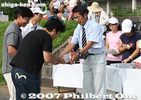
The Lake Biwa Rowing Song CDs were donated by Philbert Ono.Aug 01, 2007
|
|
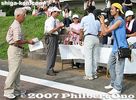
A representative from each winning team went to receive a medal and Lake Biwa Rowing Song CD. Each team had 5 members, so 5 CDs per team.Aug 01, 2007
|
|

Writing names on award certificates.Aug 01, 2007
|
|
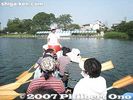
We rowed according to the taiko drum beat.Aug 01, 2007
|
|

The beautiful 15-page program included an ad for the Lake Biwa Rowing Song CD.Aug 01, 2007
|
|

Dragon boat going to the Seta-Karahashi Bridge.Aug 01, 2007
|
|
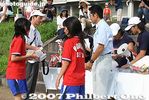
The junior category team receive their medals and CDs.Aug 01, 2007
|
|

Awards ceremonyAug 01, 2007
|
|
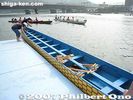
Dragon boatAug 01, 2007
|
|
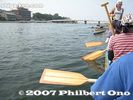
Rowing on the dragon boatAug 01, 2007
|
|

Some of the prizes awarded to the 1st, 2nd, and 3rd place winners. Notice the Lake Biwa Rowing Song CDs (75 copies).Aug 01, 2007
|
|

A taiko drummer sits at the front of the dragon boat.Aug 01, 2007
|
|

Dragon boatAug 01, 2007
|
|

Aug 01, 2007
|
|

Free rides on this dragon boat were also provided.Aug 01, 2007
|
|

Dragon boatAug 01, 2007
|
|

The Lake Biwa rowing Song CD was also sold during the regatta which lasted from 9 am to 4 pm.Aug 01, 2007
|
|

Aug 01, 2007
|
|

Sketch of regatta courseAug 01, 2007
|
|

Aug 01, 2007
|
|

Finish line. In the background is the Kyoto University Rowing Club's boat house.Aug 01, 2007
|
|

CDsAug 01, 2007
|
|

The Lake Biwa rowing Song CD was also sold.Aug 01, 2007
|
|

The 250-meter course is very short, and each race ends within a minute or two.Aug 01, 2007
|
|

The race had to be stopped for a few minutes each time this cruise boat passed by.Aug 01, 2007
|
|

Most races were not close.Aug 01, 2007
|
|

Aug 01, 2007
|
|

Aug 01, 2007
|
|

Aug 01, 2007
|
|

Aug 01, 2007
|
|

All the boats are held stationary with a rope provided from the bridge.Aug 01, 2007
|
|

Aug 01, 2007
|
|

Aug 01, 2007
|
|

Seta-Karahashi Bridge, the start line.Aug 01, 2007
|
|

Up to four rowing teams raced down a 250-meter straight course.Aug 01, 2007
|
|

Aug 01, 2007
|
|

A rowing team leaves the dock for Seta-Karahashi Bridge seen in the background.Aug 01, 2007
|
|

On July 29, 2007, this regatta was held for the second time. It targets mainly beginner rowers. Organized by the Seta Rowing Club which seeks to have more people enjoy water sports on Lake Biwa. Seta-Karahashi Bridge was the regatta's starting line. The Lake Biwa Rowing Song CD was awarded to all the 1st, 2nd, and 3rd place winners in all five categories. Aug 01, 2007
|
|

Sixty rowing teams (300 people) rowed in five categories, including beginner and expert rowers, ranging in age from junior high to senior citizens.Aug 01, 2007
|
|

This is the boat dock where people got on and off the boats. The boats were provided by local rowing organizations. The regatta was organized by the Seta Rowing Club in Otsu.Aug 01, 2007
|
|
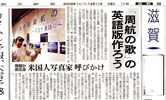
"Let's make an English version of Biwako Shuko no Uta," Dec. 11, 2005, Asahi Shimbun, Shiga NewsJul 19, 2007
|
|
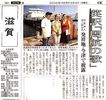
"Lake Biwa Rowing Song performed in public in Imazu, the song's birthplace," June 4, 2006, Yomiuri Shimbun, Shiga NewsJul 19, 2007
|
|
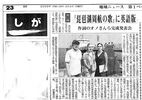
"Lake Biwa Rowing Song completed in English and performed in public," June 4, 2006, Mainichi Shimbun, Shiga NewsJul 19, 2007
|
|
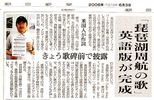
"Lake Biwa Rowing Song completed in English by an American," June 3, 2006, Asahi Shimbun, Shiga NewsJul 19, 2007
|
|

"Lake Biwa Rowing Song photo exhibition in Takashima," June 12, 2006, Chunichi Shimbun, Chunichi-Shiga page. (The man in the picture is not Philbert.)Jul 19, 2007
|
|

"13 contestants in Japanese speech contest by foreigners in Shiga," Feb. 26, 2007, Kyoto Shimbun, Shiga NewsJul 19, 2007
|
|
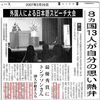
"Japanese speech contest by foreigners in Shiga, Ms. Thompson wins," Feb. 26, 2007, Mainichi Shimbun, Shiga EditionJul 19, 2007
|
|

"Japanese speech contest by foreigners in Shiga," Feb. 26, 2007, Chunichi Shimbun, Chunichi-Shiga pageWon by Jamie Thompson for her speech about Lake Biwa Rowing Song.Jul 19, 2007
|
|

"Lake Biwa Rowing Song postcards on sale," June 16, 2006, Asahi Shimbun, Shiga EditionSold at Biwako Shuko no Uta Shiryokan in Imazu.Jul 19, 2007
|
|

"Lake Biwa Rowing Song sung during Lake Biwa Cruise," June 17, 2007, Kyoto Shimbun, Shiga Edition.Jul 19, 2007
|
|

"Lake Biwa Rowing Song CD on sale," June 17, 2007, Asahi Shimbun, Shiga Edition.Jul 19, 2007
|
|

"Lake Biwa Rowing Song photo exhibition at Imazu," June 5, 2007, Chunichi Shimbun, Biwako EditionJul 19, 2007
|
|

"Lake Biwa Rowing Song photo exhibition at Yokaichi Public Library," (Letter to the Editor), May 26, 2007, Kyoto Shimbun.Written by Masahiro Beniya.Jul 19, 2007
|
|

The work proceeds.Jul 09, 2007
|
|
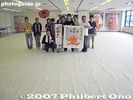
After every kite-making session, they take a picture of all the volunteer participants. It was very interesting. Anybody can participate on any day. Call the kite museum for schedule details: 0748-23-0081.Jul 09, 2007
|
|

The sheets are joined in the same pattern as a brick wall. Every other row of sheets has a half sheet along the edge. Notice the autographs of people on the paper.Jul 09, 2007
|
|
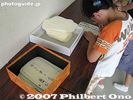
There are also smaller sheets of paper where you can write a wish and sign your name. Paste will be applied to these sheets which will be used to fasten the bamboo frame to the giant paper.Jul 09, 2007
|
|

The giant kite paper is finished, taking up the floor space of the entire room.Jul 09, 2007
|
|
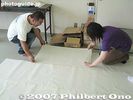
The last sheet is pasted and joined. The job was finished in 3 hours.Jul 09, 2007
|
|

So the giant kite is actually made of many smaller sheets of paper joined together. Notice my "philbert" autograph on the bottom.Jul 09, 2007
|
|
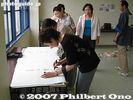
People sign their names on a washi sheet.Jul 09, 2007
|
|

Anybody can help do this. The public is invited to sign their names on a sheet and paste it to the big kite paper.Jul 09, 2007
|
|

The paper is Mino Washi, from Gifu Prefecture. It is white, and surprisingly thin. I thought it would be thicker. Six or so sheets are stacked while slightly spread apart.Jul 09, 2007
|
|

The stacked paper is put on a table where water-based paste is applied to one horizontal and one vertical paper edge.Jul 09, 2007
|
|

Each person holds one edge-pasted sheet and line up to align and join the sheet. Each sheet measures about 90 cm by 60 cm. There are also half-size sheets.Jul 09, 2007
|
|

The top two rows of washi sheets already pasted together.Jul 09, 2007
|
|

The size of the room almost exactly matches the size of the giant kite which is 12 meters by 13 meters or 100 tatami mats.Jul 09, 2007
|
|

July 8, 2007: On the day after the pasting ceremony, the Kamitsugi or paper joining was next. 紙継ぎJul 09, 2007
|
|
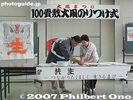
More dignitaries paste the sheets of kite paper together.Jul 09, 2007
|
|

The kite design announcement and pasting ceremony lasted an hour, after which a group photo was taken.Jul 09, 2007
|
|

Starting at 9:30 am, members of the giant kite preservation society began pasting and joining about 400 sheets of washi paper to make the giant kite paper.Jul 09, 2007
|
|

We were then invited to sign our names on the kite paper.Jul 09, 2007
|
|

The pasted pieces are laid to dry.Jul 09, 2007
|
|

They joined two sheets of kite paper together. This marked the first step in making the kite. The finished kite paper will consist of a few hundred washi paper sheets pasted together.Jul 09, 2007
|
|

Higashi-Omi mayor Nakamura Koichi explains the design. "Kyosei" 共生 means to co-exist (i.e. man and nature) or to live together harmoniously. 中村功一市長Jul 09, 2007
|
|

They used a wide brush to apply paste to the edges of a piece of kite paper.Jul 09, 2007
|
|

The mayor and one of the kite design artists wear a sash and pose for a picture before proceeding with the Noritsuke Ceremony.Jul 09, 2007
|
|

Twenty-six design entries were submitted this year. There was no top winner, so the final design was based on the three best designs. This design features the kanji "Yorokobu" or joyfulness. 今回のテーマは「いのち」Jul 09, 2007
|
|

The top kanji is "yorokobu" (joyfulness) which can also be read as "ki." The pair of hawks 鷹 can be read as "yo." And the bottom kanji is "sei" (living). It's "Kyosei."Jul 09, 2007
|
|

They introduced the three best designs. 最優秀作品はなく、3点の優秀賞作品を参考に保存会が決めた。Jul 09, 2007
|
|
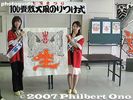
The new kite design was then announced. Called Han-jimon (判じもん), the design expresses a certain theme using word play with a pair of animals and one or two kanji characters. 八日市大凧は3年に一度図柄を変える。Jul 09, 2007
|
|

During July-Aug. 2007, I helped to make the Yokaichi giant kite at the annex of the Yokaichi Giant Kite Museum.where the giant kite is made. Every three years, the giant kite, flown every May in Higashi-Omi, is replaced by a new kite bearing a new design.The new kite was made during July-Aug. 2007, taking about 30 days. The kite is made by volunteers from the public under the instruction of the Yokaichi Giant Kite Preservation Society. For the first time, I helped make this giant kite which was first flown successsfully on May 25, 2008 at the annual kite festival.Jul 09, 2007
|
|

Entrance to the annex and a sign indicating the day's event or work. Today, July 7, 2007, was the Noritsuke Pasting Ceremony. 八日市大凧まつり のりつけ式Jul 09, 2007
|
|

Before announcing the final kite design, they announced the three best (but not winning) design entries. The public was invited to submit kite designs based on the theme of "Life" or inochi.Jul 09, 2007
|
|
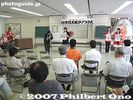
July 7, 2007: The making of the giant kite started with Noritsuke Pasting Ceremony where the new design was announced and dignitaries pasted together the first pieces of the kite paper.Jul 09, 2007
|
|
|

Jamie sang by herself (without twin sister Megan), however, we provided piano music which included only Megan's voice. So it sounded like both sisters were singing. First time we did that.Jun 25, 2007
|
|

June 24, 2007 Hikone VOICE World Gathering was an annual event of this international exchange group in Hikone. Held at Viva City Hall in Minami-Hikone.Jun 25, 2007
|
|

The event featured various international entertainment by a Russian troupe and local foreign students attending universities in Shiga. The last performance was by Jamie Thompson who sang Lake Biwa Rowing Song.Jun 25, 2007
|
|
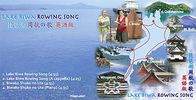
Cover of Lake Biwa Rowing Song CD which went on sale on June 16, 2007. Details here.Jun 22, 2007
|
|

Getting back on the boat. Little over a hundred people came on this cruise. If people knew it was gonna be such a beautiful day during this rainy season, more would have certainly come.Jun 21, 2007
|
|

Jamie and Megan Thompson singing in front of Verse 4 song monument on Chikubushima. This was during a Lake Biwa cruise.Jun 21, 2007
|
|
|

June 16, 2007 Singing in front of Verse 4 song monument on Chikubushima.Jun 21, 2007
|
|

Jamie and Megan Thompson singing during a Lake Biwa cruise.Jun 21, 2007
|
|

In the end, we all sang the song, including the mayor of Takashima.Jun 20, 2007
|
|

最後に皆で周航歌を歌う。Jun 20, 2007
|
|

Meeting Iida Tadayoshi, song researcher and former NHK announcer.Jun 20, 2007
|
|

A reception was held afterward in the hotel. The mayor of Takashima, Hidekazu Kaito, speaks. I gave him a copy of our CD. 高島市長 海東英和Jun 20, 2007
|
|
|

Interestingly, the mayor's first name "Hidekazu" means "English-Japanese." The next day, at the choir contest, he told us that he listened to and liked our song.Jun 20, 2007
|
|

View of Imazu shore from hotelJun 20, 2007
|
|

Another local landmark was this former bank building designed by William Merrell Vories who designed many buildings in Shiga, especially in Omi-Hachiman.Jun 20, 2007
|
|

Inside former bank building.Jun 20, 2007
|
|

In the evening during 5 pm-6:30pm, a slide show lecture about Oguchi Taro and Yoshida Chiaki was given by Iida Tadayoshi, a song researcher. Held at a hotel in Imazu. 歌と映像でつづる「小口太郎と吉田千秋の物語」講演会Jun 20, 2007
|
|

Kanpai!Jun 20, 2007
|
|

Inside Chojiya. Very impressive Japanese-style inn with lake views.Jun 20, 2007
|
|

Chojiya ryokan along the lake shore. Likely this is where Oguchi Taro and crew stayed. 丁子屋という旅館Jun 20, 2007
|
|

Inside Chojiya. The inn is famous for serving duck.Jun 20, 2007
|
|
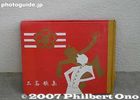
Daisan Koto Gakko book of songsJun 20, 2007
|
|

German-made accordian used by Yoshida Chiaki was also on display.Jun 20, 2007
|
|

This showcase showed things from the old Daisan Koto Gakko college.Jun 20, 2007
|
|

Daisan Koto Gakko Rowing club towelJun 20, 2007
|
|

「周航の物語展」今津東コミセンJun 20, 2007
|
|

Room in Chojiya ryokan.Jun 20, 2007
|
|

Student uniform for Daisan Koto Gakko school.Jun 20, 2007
|
|

Water lilies. The melody of the song originally came from a song called "Hitsuji-gusa" which means water lilies.Jun 20, 2007
|
|

After the boat cruise, there was a walking tour of Imazu. A special exhibition was held at the local community center in Imazu. 「周航の物語展」今津東コミセンJun 20, 2007
|
|
|
|

Water lily (Hitsuji-gusa). ひつじぐさJun 20, 2007
|
|

Jamie and Megan Thompson sing in English while cruising on Lake Biwa. 船の真ん中で歌って自動販売機がバックになって最悪。客に背中を向くばかりで申し訳ない。船の一番前に歌いたいと頼んだけど...Jun 20, 2007
|
|

After they sang, there was a mad rush to buy the CD priced at 800 yen. 英語版CDの購入者が殺到。Jun 20, 2007
|
|

More autographs. 姉妹はやはり人気者。Jun 20, 2007
|
|

Then they signed autographs on the CD. CDのサインを求める。Jun 20, 2007
|
|

Sachiko Tsuji, the MC, interviews the sisters before they sang on the boat. 自動販売機前でインタービュー。船内の客は姉妹の顔や姿がほとんど見えへん。Jun 20, 2007
|
|

Jamie and Megan Thompson sing in English in front of the Verse 4 song monument, Chikubushima. They sang up to Verse 4. ジェイミーとメゲン・トンプソン姉妹が歌うJun 20, 2007
|
|

The man holds the 90th Anniversary tour sign as a guide for the tour guests.Jun 20, 2007
|
|

Jamie and Megan Thompson sing in English in front of the Verse 4 song monument, Chikubushima. Next time we need to have an amplifier.Jun 20, 2007
|
|

We landed on Chikubushima for about an hour. Jamie and Megan also sang in English in front of the Verse 4 song monument.Jun 20, 2007
|
|

So what does "Coral shrine" mean in the song? (There's no coral in the lake.) "I think it just refers to a beautiful place..." 「珊瑚の宮」はどういう意味?Jun 20, 2007
|
|
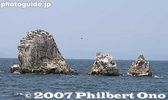
Okino-shiraishi Rocks, a favorite resting place for birds which turned the rocks white from bird droppings. Four rocks stand 80 meters deep in the lake. Out of the water, the tallest stands 14 meters high. 沖の白石Jun 20, 2007
|
|

Rolling with the wavesJun 20, 2007
|
|

Omi-Maiko appears in the song.Jun 20, 2007
|
|

Shirahige Shrine 白髭神社Jun 20, 2007
|
|

Omi-Maiko with green pines on white sands. 近江舞子の「松は緑に 砂白き」Jun 20, 2007
|
|
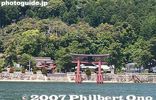
Shirahige Shrine torii as seen from the cruise boat.Jun 20, 2007
|
|

We passed by various scenic spots such as Shirahige Shrine, noted for the torii gate in the lake.Jun 20, 2007
|
|

Open deck at the rear. The boat departed at about 11:30 am.Jun 20, 2007
|
|

Boat name "Rio Grande" operated by Biwako Kisen. Named after Shiga's sister state in Brazil. There is also the "Michigan" paddlewheel boat named after Shiga's sister state in the USA.Jun 20, 2007
|
|

Inside the front of the Rio Grande boat. 琵琶湖周航クルージングJun 20, 2007
|
|

Boarding time at Imazu Port. In the forefront is a song monument for Biwako Shuko no Uta.Jun 20, 2007
|
|

Megan and Jamie Thompson about to board the boat. トンプソン姉妹Jun 20, 2007
|
|

The "Rio Grande" cruise boat awaits at Imazu Port on a miraculously sunny day during the rainy season. 梅雨でありながら、奇跡的にこんないい天気になった。今津港Jun 20, 2007
|
|

Reception desk for passengers. A little over 100 people joined the cruise. クルーズの受付Jun 20, 2007
|
|

Imazu Port. A large crowd of people waiting to board the chartered boat for a 3-hour cruise on Lake Biwa to commemorate the 90th anniversary of the song, Biwako Shuko no Uta.Jun 20, 2007
|
|

On June 16, 2007, Imazu marked the 90th anniversary of the song by organizing a boat cruise on Lake Biwa and other events. Omi-Imazu Station had a sign directing guests to Imazu Port. 90周年の記念「琵琶湖周航クルーズ」の近江今津駅内Jun 20, 2007
|
|

Corridor of coat hangersJun 15, 2007
|
|

Welcome banner.Jun 15, 2007
|
|

BankART Studio NYK gallery showing Hokule'a photos.Jun 15, 2007
|
|

Makeshift planetarium where they showed the stars used by Hokule'a for navigating.Jun 15, 2007
|
|

Stern of Kama Hele (Yanmar engine hidden below)Jun 15, 2007
|
|
|

During Hokule'a's stay in Yokohama, there also were various exhibitions, lectures, and events.Jun 15, 2007
|
|

Entrance to BankART Studio NYK, a gallery complex.Jun 15, 2007
|
|

Getting off the canoeJun 15, 2007
|
|

Hokule'a T-shirt sold by the Hawaii Visitors Bureau (all sold out).Jun 15, 2007
|
|

View from pierJun 15, 2007
|
|

Other sponsorsJun 15, 2007
|
|

RudderJun 15, 2007
|
|

Japanese, Hawaiian, and Yanmar (sponsor) flags on the Kama Hele, escort boat for Hokule'a. (Yanmar is a marine engine maker from Shiga Prefecture.)Jun 15, 2007
|
|

Escort ship Kama Hele (not open to visitors)Jun 15, 2007
|
|

PierJun 15, 2007
|
|

Jun 15, 2007
|
|

Close-up of steering paddle or Hoe uli, made of wood.Jun 15, 2007
|
|

Hull storage. The wooden cover was made by a Japanese carpenter whose name is on it. Many parts of Hokule'a bear the name of the person who made that part.Jun 15, 2007
|
|

Rudder (steering paddle or Hoe uli)Jun 15, 2007
|
|

Talk by crew member named Dean. The interpreter was Kyoko Ikeda, Asian Pacific Leadership student.Jun 15, 2007
|
|

Aft sailJun 15, 2007
|
|

Above both hulls are storage bins and sleeping quarters.Jun 15, 2007
|
|

Base of aft mast (Kia hope). The woodwork here was exquisite, and looked quite expensive.Jun 15, 2007
|
|

FoodJun 15, 2007
|
|

Canvas covering (kapalina) the sleeping quarters over the hull.Jun 15, 2007
|
|

Under the bed padding (red) is storage bins, including an opening to the hull where more stuff is stored.Jun 15, 2007
|
|

Sleeping compartment provides bed padding with a built-in pillow. Above it is the canvas covering (kapalina).Jun 15, 2007
|
|

Covering the top of hull is a canvas covering (kapalina) fastened by rope to the safety railing (palekana). The canvas is also a tent-like roof for the sleeping quarters.Jun 15, 2007
|
|

Canoe deck (pola)Jun 15, 2007
|
|

Captain's dry thingsJun 15, 2007
|
|

Jun 15, 2007
|
|

Galley or "da kitchen."Jun 15, 2007
|
|

Navigator's seat (kilo) at the stern. The black thing is apparently a seat cushion. Another one on the opposite side.Jun 15, 2007
|
|

GalleyJun 15, 2007
|
|

Canoe deck is littered with waterproof containers for food and other essentials.Jun 15, 2007
|
|

All the fresh food (perishables) are consumed during the first few days after leaving a port. After that, it's canned food, dry goods, and fish caught in the water.Jun 15, 2007
|
|

Fresh food storage (onions)Jun 15, 2007
|
|

Solar panel in the forefront. Power is used for communications equipment.Jun 15, 2007
|
|

Jun 15, 2007
|
|

Female goddess on the right.Jun 15, 2007
|
|

Kanako Uchino talks about the canoe in Japanese.Jun 15, 2007
|
|

Male god on the left.Jun 15, 2007
|
|

Jun 15, 2007
|
|

Stern. The pointy stern endpieces are called "Manu hope" in Hawaiian.Jun 15, 2007
|
|

Holding on to the steering paddle so it doesn't bump anyone.Jun 15, 2007
|
|

Rudder going into the waterJun 15, 2007
|
|

Mast complemented by koinobori carp.Jun 15, 2007
|
|

Jun 15, 2007
|
|

Koinobori carp streamers for a Japanese touch. These are flown in Japan during early May for Children's Day.Jun 15, 2007
|
|

Ropes crisscross everywhere.Jun 15, 2007
|
|

The white vertical board (the woman sitting on it) is a splash guard (called pale wai or pale kai).Jun 15, 2007
|
|
| 71466 files on 284 page(s) |
 |
 |
230 |  |
 |
|